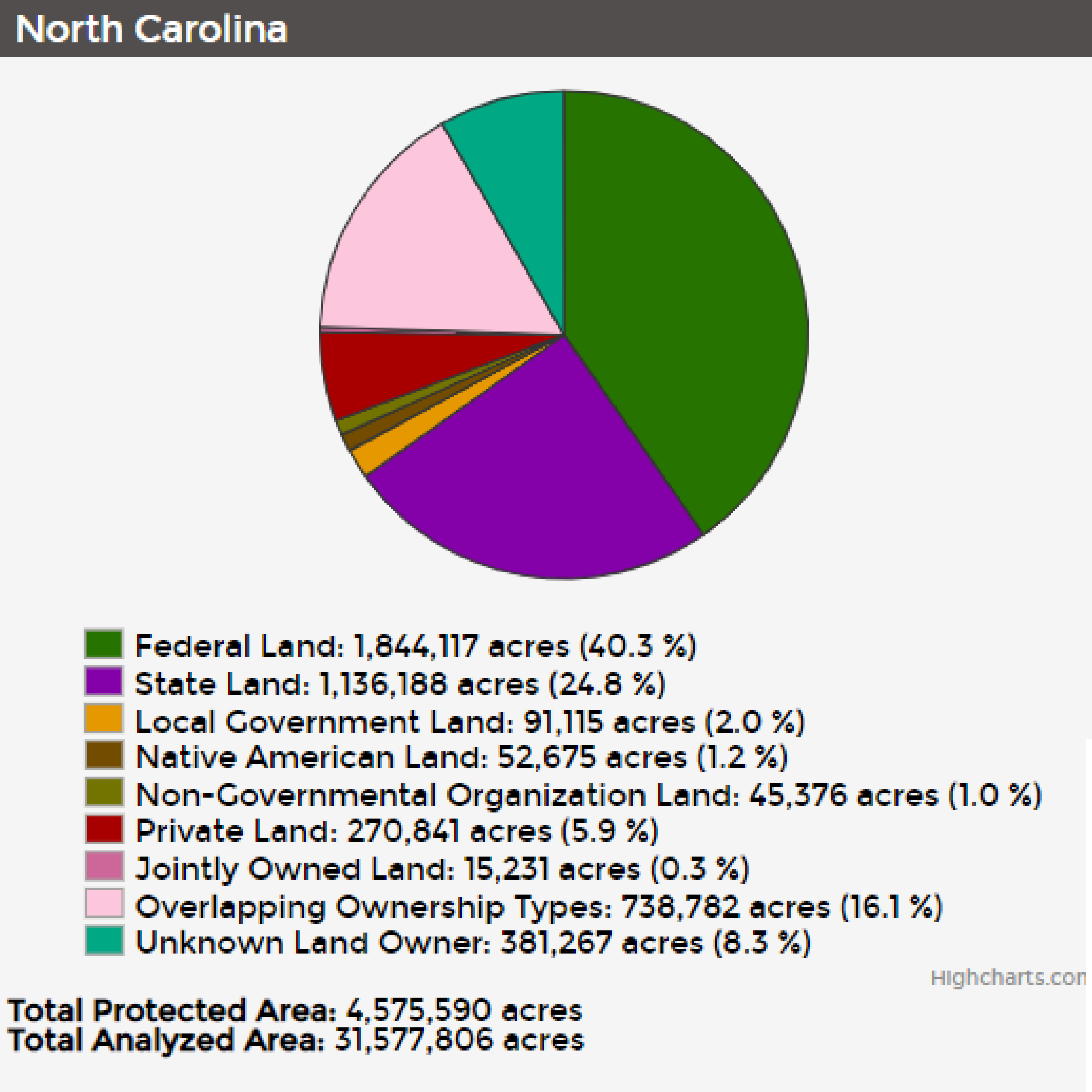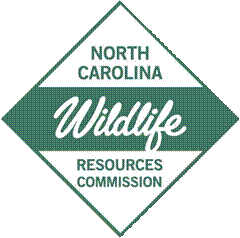
North Carolina Conservation Summary
Many Americans know North Carolina for the natural areas located at its opposite ends. Both the cool, lush-green mountains of the fog-shrouded southern Blue Ridge Mountains and the Outer Banks’ slender necklace of barrier islands host millions of visitors each year. The state, though, includes a distinctive collection of ecological treasures between these regions as well.
Protected Area by Ownership Type
 Data from PAD-US 1.4 May 2016 | U.S. Geological Survey, Gap Analysis Program (GAP)
Data from PAD-US 1.4 May 2016 | U.S. Geological Survey, Gap Analysis Program (GAP)
Rare Species and Characteristics
North Carolina is home to many rare and intriguing species: at least 990 vertebrate species (excluding marine fishes), more than 3,500 invertebrates, and over 5,500 species of plants and mosses.
There are many factors that influence where a species occurs in the landscape, its distribution and abundance, and its rate of reproductive success and survival. A landscape composed of multiple natural community types is more likely to contain the necessary resources to provide habitat for many species. North Carolina’s landscape composition varies across the state with elevation, moisture and temperature gradients, and soil textures having a significant influence on natural community structure.
Whether they are aquatic or terrestrial systems, natural communities and the habitats they provide are highly interconnected and influence one another. The 2015 North Carolina Wildlife Action Plan describes and categorizes the state’s diverse landscapes using four ecoregions as a framework. Information about numerous aquatic, wetland, and terrestrial upland communities can be found in Chapter 4 of the document. Highlights about the ecoregions and some of the unique landscapes that can be found in them include the following:
The mountain ecoregion in the westernmost part of the state is part of the Southern Appalachian Blue Ridge Mountains. North Carolina’s mountains have the highest elevations of any state east of the Mississippi River, with Mount Mitchell being the highest peak at 6,684 feet above mean sea level. This ecoregion covers about 17% of the state and is predominantly forested but has small patches of agricultural and developed lands mainly in the broad valleys.
Found at elevations over 5,500 feet, Red Spruce−Fraser Fir forests are considered an endangered mountain community in North Carolina and are ranked the second most endangered ecosystem in the United States. Spruce−fir habitats in North Carolina are now found within a narrow range of suitable conditions, isolated from each other and the rest of their range. Spruce−fir provides critical habitat for numerous plant and animal species found nowhere else in North Carolina.
Many mountain streams are cold water systems that provide habitat for native species that need cold waters, such as Brook Trout and Hellbender salamanders. Bogs and fens are among the rarest of natural communities in the Southern Appalachian Mountains. Some of the wildlife species associated with mountain bogs require open, herbaceous habitat (e.g., Bog Turtles, Golden-winged Warblers, Meadow Voles, Meadow Jumping Mice, Bog Lemmings) while others prefer closed canopy wetlands (salamanders). In fact, for the Bog Turtle and the Southern Bog Lemming, bogs are the primary or sole habitat type in the state.
The piedmont ecoregion in the center of the state is bounded to the west by the Blue Ridge Escarpment and to the east by the fall line, a major break in geologic structure between the piedmont and coastal plain landscape. The piedmont contains many different types of natural systems and human-altered landscape as well as highly variable ecosystem patterns and topographic relief. Elevations generally range from about 1,500 feet in the western foothills to about 200 feet at the fall line.
Piedmont streams are primarily warmwater systems which significantly contributes to the species assemblages found in this type of aquatic habitat. Headwater and small streams are found statewide and are prevalent in the piedmont where they can be associated with small wetlands systems or originate at natural spring heads. Larger streams and rivers in the piedmont provide numerous important habitats, life cycles, or prey components to a vast assemblage of terrestrial, semi-aquatic, and aquatic wildlife. Wetlands, especially upland pools and depressions, are important breeding sites for many amphibians and some crayfish species. The Neuse River Waterdog is a fully aquatic salamander of high conservation concern found only in piedmont streams of the Neuse River Basin. There are also many birds that use riverine and adjacent terrestrial communities for nesting and feeding areas.
The sandhills covers about 3% of the state and is part of the southwestern boundary between the piedmont and coastal plain ecoregions. They are distinguished by distinctive geomorphology, vegetation, and natural community types and there is a high rate of species endemism. The Sandhills represents a former coastline and is well known for having many rare plants.
Longleaf Pine and other fire-managed ecosystems such as streamhead pocosins, occur in the sandhills. Surveys of fire-managed posocins in the Sandhills found a high territory density of shrub-nesting birds, including the Common Yellowthroat, Indigo Bunting, Eastern Towhee, and Yellow-breasted Chat. This same study found a relatively high density of cavity nesters such as the Brown-headed Nuthatch, Red-headed Woodpecker, and Carolina Wren. The federally listed Red-cockaded Woodpecker is strongly associated with upland Longleaf Pine communities in the sandhills. Other species associated with the open grass-dominated understories include Bachman’s Sparrow, Brown-headed Nuthatch, Henslow’s Sparrow, and Northern Bobwhite.
The coastal plain ecoregion includes areas east of the fall line (excluding the Sandhills) and the tidal coast (ocean, sounds, barrier islands, and mainland brackish and salt marshes). It represents about 40% of the state and lies within the Mid-Atlantic Coastline. It may be divided roughly into two sections: the tidewater area (lower Coastal Plain), which is largely flat and swampy, and the interior portion (upper Coastal Plain), which is made up of gently sloping elevations and is better drained than other regions. The average elevation is from about 200 feet at the fall line, sloping to an elevation of generally 50 feet or less over most of the mainland landscape, with barrier islands being close to sea level.
Tidal freshwater wetlands provide nursery habitat for aquatic species that live in saltwaters but rely on fresh and brackish waters for larval recruitment and development. Many of these species are economically or commercially important, such as crabs, shrimp, and flounder species. Several rare, disjunct, or endemic species—Carolina Watersnake, Aaron’s Skipper, and several moths—are associated with brackish marsh habitats in the sounds of the northern coastal plain Wayne’s Black-throated Green Warbler is nearly confined to non-riverine swamp forests throughout its narrow range from Virginia to South Carolina. This taxon is declining throughout its range, and loss of the population on the Albemarle–Pamlico Peninsula (believed to be the largest remaining) due to rising sea levels would significantly reduce the chances of its survival overall.
Many of the state’s natural communities cover large areas and are well represented, while others cover small portions of the state and are more at risk from loss of biodiversity when considering local and regional threats (i.e., land use change, development). Given the richness of North Carolina’s biodiversity, the ecosystem services provided by the natural communities, and the benefits provided to fish and wildlife, certain natural community types are of higher priority for land conservation because they are more imperiled.
Threats
Much of central North Carolina has long been converted to agriculture and dense human settlement. But areas previously considered too wet, steep, sandy or rocky—where most of the state’s important natural areas occur—are now under threat. Development is transforming neglected parts of the coast, mountain ridges and inland reservoir shorelines into densely packed vacation and retirement communities. While most of the state’s longleaf pine forests were swept away in past rampages of timbering, other forested communities are now prone to heavy logging or subject to conversion to plantation rows of loblolly pine and non-native slash pine. More formerly marginal lands face the threat of exploitation from biofuels development or the industrial infrastructure to support oil and gas drilling off the Outer Banks.
The direct impacts of human exploitation are pervasive, but secondary degradation vastly extends the damage to natural ecosystems. Aquatic species in particular bear the brunt of almost all human activities. While breaches in hog farm lagoons get public notice, siltation, polluted runoff from residences and farms, and hydrological changes resulting from increased stormwater discharge cumulatively imperil the freshwater mussels, fish, and stream insects not yet extirpated or on the brink of extinction.
Just as quietly but equally devastatingly, lack of natural fire continues to transform much of the state’s upland forests. Exotic species like Japanese stilt grass, Chinese privet, and Asiatic clams proliferate at the expense of native species and communities. Even more devastating are diseases and introduced predators: chestnut blight fungus, balsam and hemlock adelgids, gypsy moths, fire ants, and flathead catfish all directly attack the native flora and fauna, driving some species close to extinction.
More subtle but still important is landscape fragmentation. Developed areas and busy four-lane highways increasingly divide the state into many isolated blocks of habitat, while dams create major barriers for aquatic and streamside species, isolating smaller, more fragile populations where riverine and riparian habitats aren’t converted outright.
Global climate change may yet dwarf all these impacts. Accelerated rise in sea levels, accompanied by increases in catastrophic storms, are likely to have devastating effects on North Carolina’s barrier islands, sounds, and outer Coastal Plain environment. Breaching of the barrier islands that now protect the sounds from ocean tides would instantly alter one of the state’s most distinctive regions, and the numerous species isolated in the cold climate on high mountain peaks are particularly vulnerable to warming temperatures.
Public and Private Conservation Efforts
Nearly half of North Carolina's significant natural heritage areas are protected, thanks to strong conservation partnerships involving state agencies, including the Wildlife Resources Commission, Division of Parks and Recreation, Division of Water Quality, and Department of Transportation, federal agencies such as the U.S. Fish and Wildlife Service, national organizations like The Nature Conservancy, and the state’s regional land trusts, local governments, and universities. The North Carolina Natural Heritage Program provides critical information on nearly all of the state’s conservation funding decisions, including two of the most notable: the Natural Heritage Trust Fund, which provides supplemental funding to select state agencies for the acquisition and protection of important natural areas, to preserve the state’s ecological diversity and cultural heritage, and to inventory the natural heritage resources of the state; and the Clean Water Management Trust Fund, which makes grants to local governments, state agencies and conservation non-profits to help finance projects that specifically address water pollution problems.





